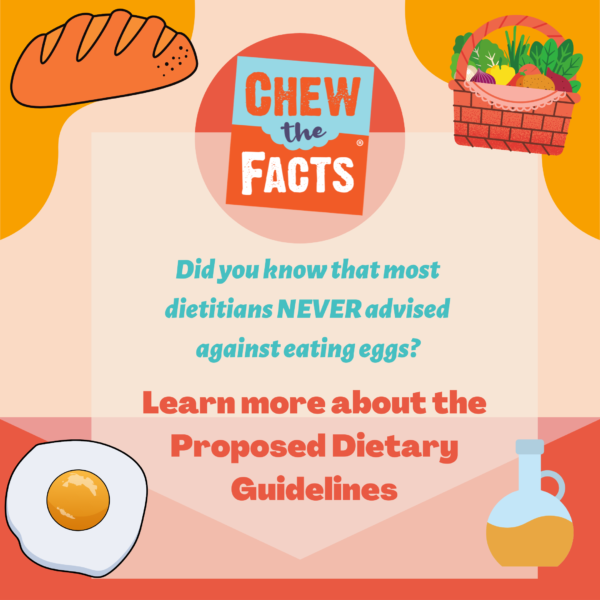Every five years, the Dietary Guidelines for Americans (DGA) are updated. The process involves a first step where a committee of experts reviews the current guidelines, and the latest research about diet, nutrition and health, and then makes recommendations. This time around they really took a look at how nutritional needs vary across the lifecycle.

The committee focused on couple of important themes:
- The importance of considering life stage in the Dietary Guidelines for Americans
- Dietary patterns provide a framework for the Dietary Guidelines for Americans within and across life stages
Nutrition through the Lifecycle
Good nutrition has the potential to influence your health through the lifecycle. This “lifecycle” includes human health during pregnancy, lactation, birth to age 24 months, childhood, adolescence, and through adulthood. Evidence suggests that consuming foods within healthy dietary patterns before and/or during pregnancy may modestly reduce the risk of gestational diabetes, hypertensive (high blood pressure) disorders of pregnancy and preterm birth.
Even small improvements in recommended food patterns during each lifecycle stage can have a positive effect on health. Click To TweetEating well really isn’t about individual foods, but instead is about eating patterns. That is, what you consistently eat over the course of a week or month. For that reason, I tend to encourage variety and moderate intakes of foods that we know could have adverse effects on health (sugar and saturated fat for instance).
Food Allergy Risk
One of the consideration the DGA Committee examined is the relationships between aspects of maternal diet during pregnancy and infant status, as well as longer-term child outcomes. This included the risk of food allergies and eczema. They found that consuming common allergenic foods, such as eggs and cow milk, during pregnancy did not appear to be associated with an increased risk of food allergies, asthma, and related atopic disease (eczema) in the child. In addition, restricting these foods was not associated with a decreased risk of these conditions.
We now know that introducing known allergens (cow’s milk, eggs, peanuts) early in an infant’s life actually reduces the risk of allergy. From birth to 12 months, infants should consumer breast milk or infant formula, and water. After age one, cow’s milk can be introduced. Once infants are ready for solids (usually around 5 months), foods like peanut butter and eggs can, and should, be introduced during the first year. All foods should be introduced in a safe way and appropriate way that avoids choking hazards (check with your pediatrician). So, it’s perfectly fine to offer scrambled eggs at around 6-8 months as a first food!
Focus on Fats
The Committee continues to recommend replacing saturated fats with unsaturated fats, but have removed specific recommendations about dietary cholesterol.
Found only in animal products, dietary cholesterol has never really been a big deal from a dietitian’s perspective. Why? Because when we counsel patients, we usually find a lot more fat in the diet, as opposed to dietary cholesterol. Saturated fat can be hidden in lots of packaged foods, so it’s important to read labels. Limit the fat, and you often naturally reduce cholesterol as well. Therefore, from a practical aspect, this has been the goal for 40 years: Replace most of the saturated fat in your diet with fat sources that provide unsaturated fat.
Egg Nutrition
Speaking of practicality, this is where the backstory about eggs come in. Yes, egg yolks are high in dietary cholesterol. While the popular media made egg’s cholesterol content into a big deal years ago, but we dietitians knew it wasn’t about eggs nor cholesterol. It’s always been about the totality of the diet. By removing foods that contributed too much saturated fat to the diet, you naturally also reduce dietary cholesterol.
Eggs happen to provide an array of nutrients in their 70-calorie package. They are inexpensive, easy to cook, and can be used for breakfast, lunch or dinner. An egg includes 6 grams of protein, 2 grams of monounsaturated fat, 1 gram of polyunsaturated fat (good fats) and only 1.5 grams of saturated fat. Eggs also include vitamin A, B vitamins, phosphorus, selenium and choline.
Choline supports cellular growth and metabolism and has been shown to be an important nutrient that supports early brain development during pregnancy. You can find some choline in cruciferous vegetables (broccoli, cabbage, cauliflower) but it’s mostly found in animal products.
Try these easy egg cups. They’re great because you can use a different filling for each, and they are perfectly portioned. You’ll also find a version of these in my new cookbook.




